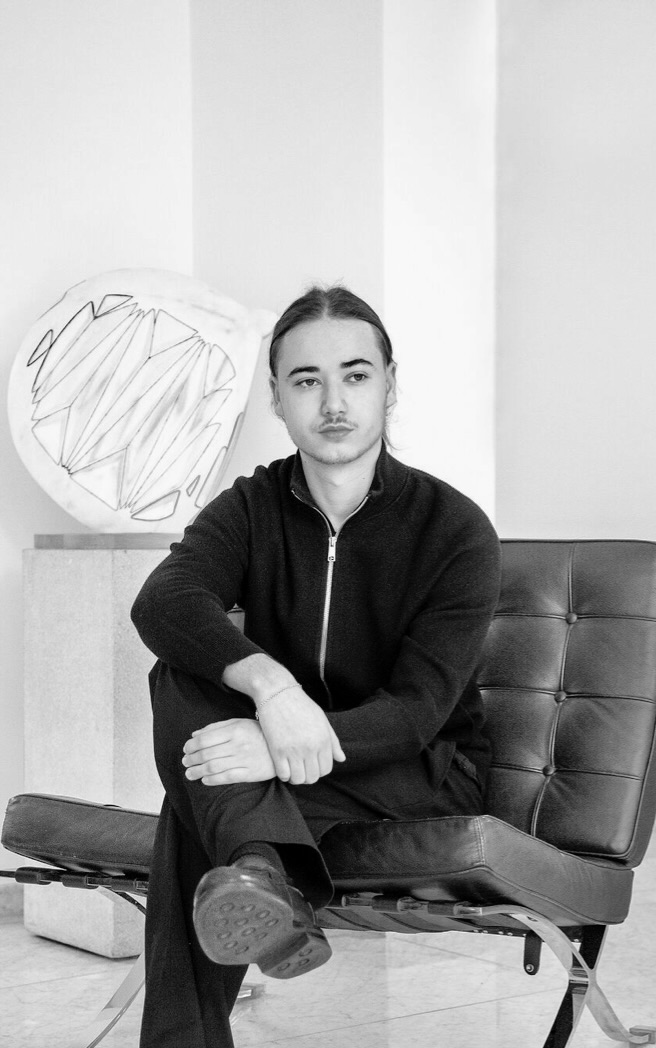Evren Alexander Nelson was born and raised in Wiesbaden, Germany – a blend, as the 22-year old put it, “of German, American, and Turkish heritage, which allowed me to grow up immersed in all three cultures.”
As a teen, he discovered and nurtured his passion for fashion, exploring various design narratives to express identity. “I was captivated by the holistic curation that fashion designers could create, inspiring me to craft my own narrative through fashion,” he said.
He started his college education at Parsons Paris during the 2020-2021 pandemic, then transferred to the school’s New York campus, where he “spent considerable time developing a narrative that felt true to me. In addition to my design courses and research classes, I chose to focus on my German heritage and the design principles of modernist and timeless objects. By gathering references and implementing design principles from the Bauhaus to Dieter Rams, I cultivated a design aesthetic that channels complexity and elegance in essentialist menswear.”
CFDA spoke to the 2023 CFDA + Swarovski Foundation Re: Generation Innovation Scholar about his thesis collection, the impact the scholarship had, and his career goals.
Tell us about your Thesis Collection, the successes and challenges you had while creating it, and design aspects that speak to sustainability, innovation, and creative design thinking.
I decided that my Thesis/Capstone collection was an opportunity to explore my design language without adhering to any specific prompts. This freedom allowed me to delve into the underlying themes of my fashion design education, leading me to focus initially on German Modernism. However, as I began researching and designing my collection, I realized that while studying German design history and timeless objects by notable figures like Marcel Breuer and Mies Van Der Rohe, I sought a reference that projected the human experience and contrasted the functional and perfectionist design language of my prior research. This led me to the film “Wings of Desire” by Wim Wenders, renowned for its minimalist style and thought-provoking exploration of the human experience’s beauty and turmoil. The title of the collection, “Die Neue” (The New), is inspired by references such as “Die Neue Nationalgalerie” in Berlin and “Die Neue Typographie” by Jan Tschichold, both of which I associate with modernity and a contemporary approach. My design process began by identifying commonalities across my visual references. Using a visual reference board, I built silhouettes and developed design details to implement in the looks. The initial silhouettes were inspired by characters in the movie and significant references, further refined through design details such as the steel rod, an innovation from Bauhaus steel-framed furniture. Additionally, the pleated wing-like lining on the trench coat directly references the angel protagonists of Wenders’ 1987 film. The process involved examining traditional menswear silhouettes and studying the functionality of specific elements. A notable aspect of my thesis is the removal of the lapel on both the navy blazer and the gray overcoat, as the lapel is not a functional aspect in modern menswear. Modernizing traditional menswear codes also included replacing cuff buttons with snaps and using a double-zipper closure for the shirt. The collection’s development further involved creating prints inspired by Josef Albers and laser-engraving leather and metal washers to enhance the pieces.
All garments were fabricated from deadstock natural-based fabrics sourced in Germany and New York City. Predominantly, I worked with wool and cotton twills, and cotton shirtings. Additionally, the Albers print oversized scarf was fabricated by Knit Up, a sustainability-focused manufacturer. Garments outsourced for production were manufactured locally.
How has the CFDA + Swarovski Foundation Re: Generation Innovation Scholarship helped you as a student and budding designer? What do you most look forward to in the coming months as we continue the mentorship journey.
The CFDA + Swarovski Foundation Re: Generation Innovation Scholarship Fund has been instrumental in connecting me with industry professionals and attending events that focus on promoting talent and sustainable innovations. Regarding my thesis collection, the fund played a crucial role in providing financial independence, allowing me to select my fabrics and collaborate with others for the photo and video shoot. Additionally, the mentorship program gives me confidence in transitioning from my college education to the industry. Whether I aim to strengthen the relationship and credibility between the CFDA and other brands or utilize their advice and mentorship to become an independent designer, I feel well-prepared for the future. I eagerly anticipate learning about the various aspects beyond designing, such as curating, manufacturing, sourcing, and reaching an audience, as well as expanding my network in New York and beyond the U.S.
What are your career goals?
My goals are to build a strong foundation of experiences within the fashion industry and to find a balance between corporate and smaller businesses. I hope to gain a deeper understanding of the design process and the dynamics of working within a large-scale design team as well as a more hands-on approach from the inception of a collection to its completion. Ultimately, my aim is to establish an independent label that connects people with similar interests and allows me to expand my design narrative beyond fashion, creating timeless and approachable products. I strive to be involved in the entire process, from sketch to finish, and to maintain my passion and ambition for designing and creating in the future.
Photos by Aysan Lamby; Model: Juan Cruz Moreno; Styling: Jonathan Kolberg; Lighting: Tom Boultwood; Hair and Makeup: Mickael Ambrosino



